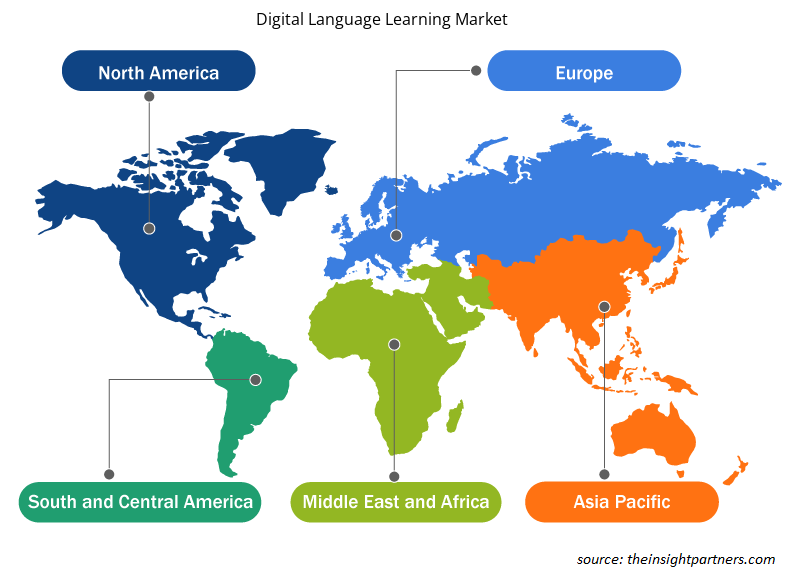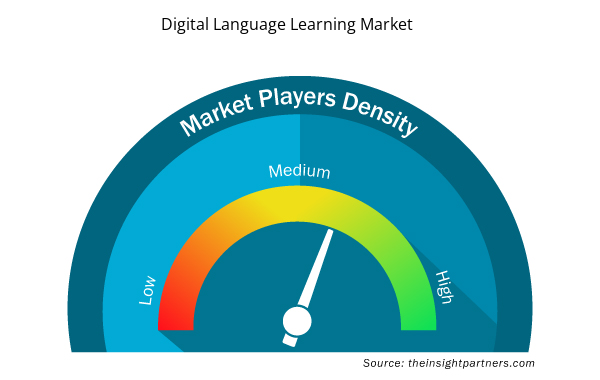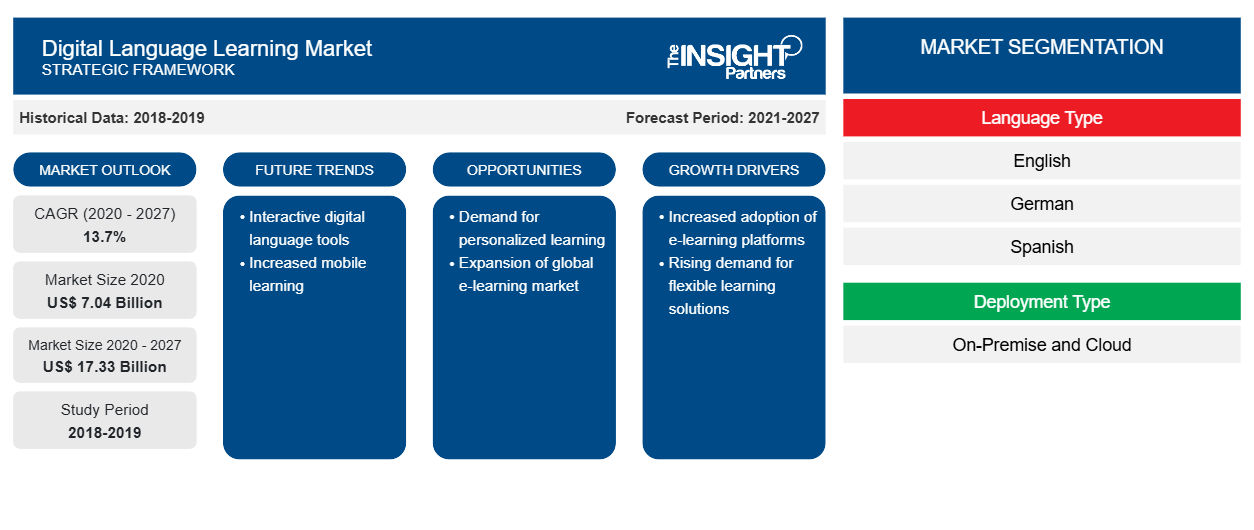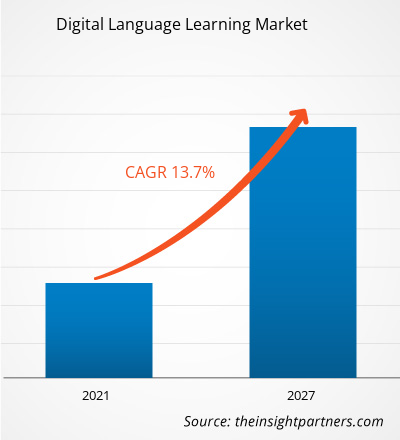Si prevede che il mercato dell'apprendimento digitale delle lingue crescerà da 7.038,2 milioni di dollari nel 2020 a 17.333,4 milioni di dollari entro il 2027; si stima che crescerà a un CAGR del 13,7% dal 2020 al 2027.
Le iniziative di vari governi per implementare programmi di apprendimento della lingua inglese stanno attribuendo alla crescita del mercato. Il settore dell'istruzione globale si sta trasformando in modo esponenziale sulla scia di varie iniziative intraprese da governi e organizzazioni private per offrire prestazioni migliorate digitalmente. I governi di vari paesi come Cina, Australia, Brasile ed Emirati Arabi Uniti hanno avviato programmi di istruzione digitale negli ultimi anni, il che ha aiutato questi paesi a potenziare i loro sistemi di istruzione in inglese. Ad esempio, la Digital Education Revolution (DER) del governo australiano, avviata un decennio fa, ha consentito a diverse scuole e università di sfruttare l'istruzione digitale. Allo stesso modo, anche il governo cinese ha avviato diverse politiche per guidare l'istruzione digitale con un'attenzione particolare all'apprendimento della lingua inglese, che ha spinto l'aumento del numero di aziende che offrono soluzioni di apprendimento digitale agli studenti cinesi. 51Talk è una delle più importanti istituzioni di apprendimento della lingua inglese digitale in Cina; 17Zuoye è un'altra piattaforma digitale per studenti, insegnanti e genitori cinesi, che fornisce compiti online sotto forma di esercizi e compiti a casa, consentendo agli utenti finali di migliorare le proprie capacità. Attualmente, l'India sta accelerando per creare un sostanziale spazio di mercato per l'istruzione digitale. Il governo indiano ha intrapreso varie iniziative per diffondere le tecnologie di digitalizzazione nel settore educativo. SWAYAM è la piattaforma di apprendimento digitale più importante e l'iniziativa intrapresa dal governo indiano, che aiuta gli studenti a scegliere corsi online, che coprono tutte le materie dell'istruzione superiore. Anche le università internazionali possono offrire i rispettivi corsi ed esami tramite la piattaforma SWAYAM, che facilita gli studenti nell'apprendimento e nella scelta degli esami dalle università internazionali. Questo fattore migliora le capacità di apprendimento, conversazione e scrittura dell'inglese degli studenti. La biblioteca digitale nazionale è un'altra iniziativa implementata dal governo indiano con la visione di offrire una fonte virtuale di risorse di apprendimento, da una struttura a sportello unico. Questa iniziativa sta gradualmente guadagnando importanza e si prevede che stimolerà il mercato dell'apprendimento della lingua inglese digitale in India per crescere nei prossimi anni, contribuendo così alla crescita del mercato globale dell'apprendimento delle lingue digitali
Personalizza questo report in base alle tue esigenze
Riceverai la personalizzazione gratuita di qualsiasi report, comprese parti di questo report, o analisi a livello nazionale, pacchetto dati Excel, oltre a usufruire di grandi offerte e sconti per start-up e università
- Scopri le principali tendenze di mercato in questo rapporto.Questo campione GRATUITO includerà analisi di dati che spaziano dalle tendenze di mercato alle stime e alle previsioni.
Impatto della pandemia di COVID-19 sul mercato dell'apprendimento delle lingue digitali
Il recente scoppio della pandemia ha portato una notevole interruzione positiva nel settore dell'istruzione esistente a livello globale negli ultimi mesi. Inoltre, l'interruzione nelle istituzioni educative convenzionali e nelle tecniche di apprendimento in aula ha assistito a un'impennata nell'adozione di soluzioni di apprendimento online e digitali solide ed efficienti che si prevede continueranno ad alimentare la crescita del mercato oltre la pandemia nei prossimi anni. Ad esempio, l'UNESCO insieme a diversi rappresentanti leader delle imprese tecnologiche e dell'ITU (International Telecommunication Union) hanno collaborato per sottolineare l'importanza economica dell'adozione di tecnologie digitali nell'apprendimento per abilitare capacità di apprendimento rapide tra un pubblico più vasto senza investimenti considerevoli in infrastrutture fisiche tra le economie emergenti.
Mentre, in un sondaggio separato condotto dall'Università di Cambridge, oltre 1.200 intervistati hanno identificato una maggiore propensione a continuare con le tecnologie di apprendimento digitale tra il 60% dei candidati al sondaggio nei prossimi anni. Quindi, il recente scoppio ha facilitato un'impennata nell'adozione delle tecnologie di apprendimento digitale e successivamente ha avuto un impatto positivo sulla crescita del mercato negli ultimi mesi
Approfondimenti di mercato: mercato dell'apprendimento delle lingue digitali
Sfruttare tecnologie avanzate e semplificate per attrarre gli studenti verso l'istruzione digitale
Nei paesi sviluppati, come gli Stati Uniti e il Regno Unito, il sistema di istruzione digitale ha guadagnato un'immensa popolarità poiché gli studenti nelle scuole, nelle università e in altre istituzioni sono completamente consapevoli delle tecnologie. Tuttavia, nei paesi APAC e SAM, gli studenti non hanno la consapevolezza dell'apprendimento guidato dalla tecnologia. Diverse scuole, università e istituti di formazione stanno implementando le tecnologie digitali nelle loro classi. Mentre gli sviluppatori di piattaforme educative digitali stanno costantemente aggiornando le loro tecnologie per offrire soluzioni solide, gli adottanti in APAC stanno costantemente aggiornando la loro infrastruttura tecnologica. Si prevede che le innovative app educative basate su cloud, i siti Web e altri servizi creeranno un mercato significativo per l'istruzione digitale, comprese le soluzioni di apprendimento delle lingue digitali.
Approfondimenti basati sul tipo di linguaggio
In base al tipo di lingua, il mercato dell'apprendimento delle lingue digitali è segmentato in inglese, mandarino, spagnolo, tedesco e altri. Il segmento inglese ha detenuto la quota di mercato più grande nel 2019.
Approfondimenti regionali sul mercato dell'apprendimento delle lingue digitali
Le tendenze regionali e i fattori che influenzano il mercato dell'apprendimento delle lingue digitali durante il periodo di previsione sono stati ampiamente spiegati dagli analisti di Insight Partners. Questa sezione discute anche i segmenti e la geografia del mercato dell'apprendimento delle lingue digitali in Nord America, Europa, Asia Pacifico, Medio Oriente e Africa e America centrale e meridionale.

- Ottieni i dati specifici regionali per il mercato dell'apprendimento delle lingue digitali
Ambito del rapporto di mercato sull'apprendimento delle lingue digitali
| Attributo del report | Dettagli |
|---|---|
| Dimensioni del mercato nel 2020 | 7,04 miliardi di dollari USA |
| Dimensioni del mercato entro il 2027 | 17,33 miliardi di dollari USA |
| CAGR globale (2020 - 2027) | 13,7% |
| Dati storici | 2018-2019 |
| Periodo di previsione | 2021-2027 |
| Segmenti coperti | Per tipo di lingua
|
| Regioni e Paesi coperti | America del Nord
|
| Leader di mercato e profili aziendali chiave |
|
Densità degli attori del mercato: comprendere il suo impatto sulle dinamiche aziendali
Il mercato del Digital Language Learning Market sta crescendo rapidamente, spinto dalla crescente domanda degli utenti finali dovuta a fattori quali l'evoluzione delle preferenze dei consumatori, i progressi tecnologici e una maggiore consapevolezza dei vantaggi del prodotto. Con l'aumento della domanda, le aziende stanno ampliando le loro offerte, innovando per soddisfare le esigenze dei consumatori e capitalizzando sulle tendenze emergenti, il che alimenta ulteriormente la crescita del mercato.
La densità degli operatori di mercato si riferisce alla distribuzione di aziende o società che operano in un particolare mercato o settore. Indica quanti concorrenti (operatori di mercato) sono presenti in un dato spazio di mercato in relazione alle sue dimensioni o al valore di mercato totale.
Le principali aziende che operano nel mercato dell'apprendimento digitale delle lingue sono:
- Babbel
- Busuu Ltd
- Fluenza
- Lingoda GmbH
- Lingua viva (Penguin Random House, LLC)
Disclaimer : le aziende elencate sopra non sono classificate secondo un ordine particolare.

- Ottieni una panoramica dei principali attori del mercato dell'apprendimento delle lingue digitali
Gli operatori che operano nel mercato dell'apprendimento digitale delle lingue si concentrano principalmente sullo sviluppo di prodotti avanzati ed efficienti.
- Nel 2019, Fluenz ha annunciato l'estensione del suo programma di immersione di lusso in spagnolo a Barcellona, in Spagna, nella primavera del 2020. Gli utenti avrebbero potuto partecipare al programma per sei giorni per apprendere la lingua.
- Nel 2018, Preply, Inc. ha annunciato i suoi piani per aprire un nuovo ufficio a Barcellona all'inizio del 2019. L'espansione è stata il risultato di un finanziamento di 4 milioni di $ a luglio. La società prevede inoltre di espandere la sua presenza nei mercati tedesco, britannico, americano e latinoamericano.
Il mercato dell'apprendimento digitale delle lingue è stato segmentato come segue:
Mercato globale dell'apprendimento delle lingue digitali - Per tipo di lingua
- Inglese
- tedesco
- spagnolo
- Mandarino
- Altri
Mercato globale dell'apprendimento delle lingue digitali - Per tipo di distribuzione
- In sede
- Nuvola
Mercato globale dell'apprendimento delle lingue digitali - Per tipo di attività
- Da impresa a impresa
- Da azienda a cliente
Mercato globale dell'apprendimento delle lingue digitali - Per utente finale
- Accademico
- Non accademico
Mercato globale dell’apprendimento delle lingue digitali – per area geografica
- America del Nord
- NOI
- Canada
- Messico
- Europa
- Francia
- Germania
- Italia
- Russia
- Regno Unito
- Resto d'Europa
- Asia Pacifico (APAC)
- Giappone
- Cina
- Australia
- India
- Corea del Sud
- Resto dell'APAC
- Medio Oriente e Africa (MEA)
- Arabia Saudita
- Emirati Arabi Uniti
- Sudafrica
- Resto del MEA
- America del Sud (SAM)
- Brasile
- Argentina
- Resto del SAM
Mercato dell’apprendimento delle lingue digitali – Profili aziendali
- Babbel
- Busuu, Ltd.
- Fluenza
- Lingoda GmbH
- Lingua viva (Penguin Random House, LLC)
- Società per azioni Pearson
- Italiano: Preply, Inc.
- Rosetta Stone, Inc.
- Società anonima Verbling Inc.
- Italiano:
- Analisi storica (2 anni), anno base, previsione (7 anni) con CAGR
- Analisi PEST e SWOT
- Valore/volume delle dimensioni del mercato - Globale, regionale, nazionale
- Industria e panorama competitivo
- Set di dati Excel


- Water Pipeline Leak Detection System Market
- Rare Neurological Disease Treatment Market
- Electronic Toll Collection System Market
- Medical Enzyme Technology Market
- Hydrogen Compressors Market
- Smart Mining Market
- Quantitative Structure-Activity Relationship (QSAR) Market
- Hydrolyzed Collagen Market
- Virtual Production Market
- Medical Second Opinion Market

Report Coverage
Revenue forecast, Company Analysis, Industry landscape, Growth factors, and Trends

Segment Covered
This text is related
to segments covered.

Regional Scope
North America, Europe, Asia Pacific, Middle East & Africa, South & Central America

Country Scope
This text is related
to country scope.
Domande frequenti
APAC region led digital language learning market. APAC comprises countries with developed educational sectors, including China, Australia, India, Singapore, and South Korea. These countries are leveraging every possible method and model to enhance English proficiency with an aim to increase the number of English speaking individuals. According to EF Education First English Proficiency Test, Asian countries hold the second position, after Europe, among the non-native English speaking countries. Over the years, countries in APAC have been investing significantly in promoting English language learning and also has lucrative opportunities for English learning.
Increasing number of Asian students migrating to western countries is the major factor driving the growth of the market. Digital English language learning is witnessing the major demand from the both academic and non-academic sectors in Asian countries. The currently increasing trend among Asian students to enroll themselves in universities in the western countries for higher education is creating a significant demand for language learning courses. Majority of the candidates from Asian countries, especially from India and China, enroll themselves for Test of English as a Foreign Language (TOEFL), International English Language Testing System (IELTS), Graduate Record Examination (GRE), Test of English for International Communication (TOEIC), and other language-based courses and certifications. TOEFL and IELTS are the tests conducted to assess a non-native candidate’s English fluency level, including proper English speaking and writing skills. This factor compels the enrolling candidates to opt for English Language Training (ELT) institutes. The burgeoning demand for these competitive exams has led to the establishment of various ELT institutions across these countries, which in turn has opened up avenues for different English learning methods.
English is the most preferred language in terms of business perspectives across the globe, and close to 30 nations worldwide have it as their primary language of communication. More than 20% of the global population speaks this language. As a result, various sectors around the world have given importance to English as a common language for communications. Further, on the back of the trending globalization, many businesses have been set in different parts of the world where English is a mandatory language for communication. Digital English language learning encompasses digital content and products that facilitate easy learning through the use of various ICT-enabled interactive tools. These tools include mobile applications, e-books, audio clips, videos, games, digital software, and online tutoring, among others. A few of the key companies operating in the digital English language learning market are Cambridge University Press, Cengage/ National Geographic Learning, and EF Education First
Trends and growth analysis reports related to Technology, Media and Telecommunications : READ MORE..
The List of Companies - Digital Language Learning Market
- Babbel
- Busuu Ltd
- Fluenz
- Lingoda GmbH
- Living Language (Penguin Random House, LLC)
- Pearson PLC
- Preply, Inc
- Rosetta Stone, Inc.
- Verbling, Inc
- Vabla, Inc
The Insight Partners performs research in 4 major stages: Data Collection & Secondary Research, Primary Research, Data Analysis and Data Triangulation & Final Review.
- Data Collection and Secondary Research:
As a market research and consulting firm operating from a decade, we have published and advised several client across the globe. First step for any study will start with an assessment of currently available data and insights from existing reports. Further, historical and current market information is collected from Investor Presentations, Annual Reports, SEC Filings, etc., and other information related to company’s performance and market positioning are gathered from Paid Databases (Factiva, Hoovers, and Reuters) and various other publications available in public domain.
Several associations trade associates, technical forums, institutes, societies and organization are accessed to gain technical as well as market related insights through their publications such as research papers, blogs and press releases related to the studies are referred to get cues about the market. Further, white papers, journals, magazines, and other news articles published in last 3 years are scrutinized and analyzed to understand the current market trends.
- Primary Research:
The primarily interview analysis comprise of data obtained from industry participants interview and answers to survey questions gathered by in-house primary team.
For primary research, interviews are conducted with industry experts/CEOs/Marketing Managers/VPs/Subject Matter Experts from both demand and supply side to get a 360-degree view of the market. The primary team conducts several interviews based on the complexity of the markets to understand the various market trends and dynamics which makes research more credible and precise.
A typical research interview fulfils the following functions:
- Provides first-hand information on the market size, market trends, growth trends, competitive landscape, and outlook
- Validates and strengthens in-house secondary research findings
- Develops the analysis team’s expertise and market understanding
Primary research involves email interactions and telephone interviews for each market, category, segment, and sub-segment across geographies. The participants who typically take part in such a process include, but are not limited to:
- Industry participants: VPs, business development managers, market intelligence managers and national sales managers
- Outside experts: Valuation experts, research analysts and key opinion leaders specializing in the electronics and semiconductor industry.
Below is the breakup of our primary respondents by company, designation, and region:

Once we receive the confirmation from primary research sources or primary respondents, we finalize the base year market estimation and forecast the data as per the macroeconomic and microeconomic factors assessed during data collection.
- Data Analysis:
Once data is validated through both secondary as well as primary respondents, we finalize the market estimations by hypothesis formulation and factor analysis at regional and country level.
- Macro-Economic Factor Analysis:
We analyse macroeconomic indicators such the gross domestic product (GDP), increase in the demand for goods and services across industries, technological advancement, regional economic growth, governmental policies, the influence of COVID-19, PEST analysis, and other aspects. This analysis aids in setting benchmarks for various nations/regions and approximating market splits. Additionally, the general trend of the aforementioned components aid in determining the market's development possibilities.
- Country Level Data:
Various factors that are especially aligned to the country are taken into account to determine the market size for a certain area and country, including the presence of vendors, such as headquarters and offices, the country's GDP, demand patterns, and industry growth. To comprehend the market dynamics for the nation, a number of growth variables, inhibitors, application areas, and current market trends are researched. The aforementioned elements aid in determining the country's overall market's growth potential.
- Company Profile:
The “Table of Contents” is formulated by listing and analyzing more than 25 - 30 companies operating in the market ecosystem across geographies. However, we profile only 10 companies as a standard practice in our syndicate reports. These 10 companies comprise leading, emerging, and regional players. Nonetheless, our analysis is not restricted to the 10 listed companies, we also analyze other companies present in the market to develop a holistic view and understand the prevailing trends. The “Company Profiles” section in the report covers key facts, business description, products & services, financial information, SWOT analysis, and key developments. The financial information presented is extracted from the annual reports and official documents of the publicly listed companies. Upon collecting the information for the sections of respective companies, we verify them via various primary sources and then compile the data in respective company profiles. The company level information helps us in deriving the base number as well as in forecasting the market size.
- Developing Base Number:
Aggregation of sales statistics (2020-2022) and macro-economic factor, and other secondary and primary research insights are utilized to arrive at base number and related market shares for 2022. The data gaps are identified in this step and relevant market data is analyzed, collected from paid primary interviews or databases. On finalizing the base year market size, forecasts are developed on the basis of macro-economic, industry and market growth factors and company level analysis.
- Data Triangulation and Final Review:
The market findings and base year market size calculations are validated from supply as well as demand side. Demand side validations are based on macro-economic factor analysis and benchmarks for respective regions and countries. In case of supply side validations, revenues of major companies are estimated (in case not available) based on industry benchmark, approximate number of employees, product portfolio, and primary interviews revenues are gathered. Further revenue from target product/service segment is assessed to avoid overshooting of market statistics. In case of heavy deviations between supply and demand side values, all thes steps are repeated to achieve synchronization.
We follow an iterative model, wherein we share our research findings with Subject Matter Experts (SME’s) and Key Opinion Leaders (KOLs) until consensus view of the market is not formulated – this model negates any drastic deviation in the opinions of experts. Only validated and universally acceptable research findings are quoted in our reports.
We have important check points that we use to validate our research findings – which we call – data triangulation, where we validate the information, we generate from secondary sources with primary interviews and then we re-validate with our internal data bases and Subject matter experts. This comprehensive model enables us to deliver high quality, reliable data in shortest possible time.


 Ottieni un campione gratuito per questo repot
Ottieni un campione gratuito per questo repot